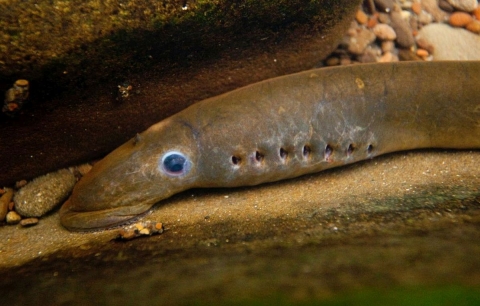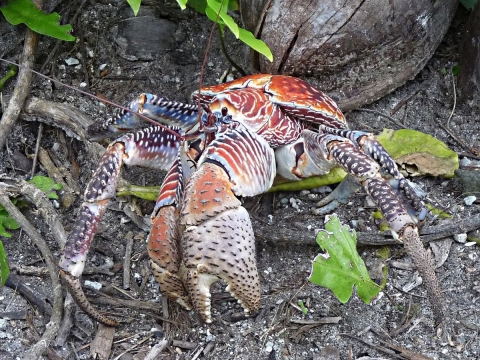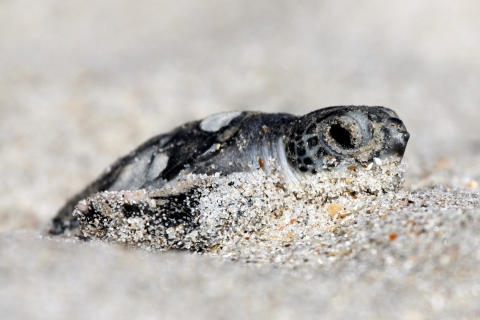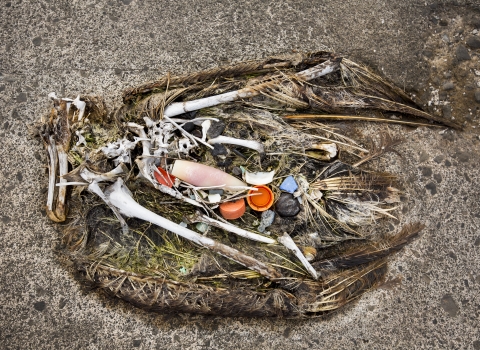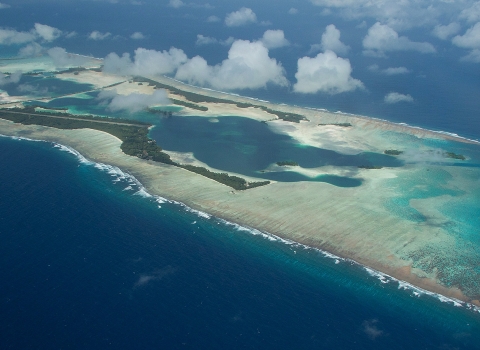No matter your age or level of knowledge, the ocean has lots to teach. That’s not surprising, given that the planet’s liquid layer is a vital Earth organ, regulating our climate and producing more than half the oxygen we breathe. It’s also a major food supplier, transportation avenue and recreation source. And, particularly at its lower depths, it’s still a source of mystery.
Wherever you look — science teachers, take note — you’ll find plenty to measure, monitor and model. You’ll also find terrific resources available from the National Oceanic and Atmospheric Administration, NatGeo, Smithsonian and the U.S. Fish and Wildlife Service, among others.
Here are eight ocean themes ripe for exploring with your students. See the educational standards they meet at the bottom of each section.
Modify lessons as needed. Themes are adaptable to fit different grades — or meet different standards. Enjoy your exploration!
Human Impacts
Focus: Albatross bolus, Midway Atoll National Wildlife Refuge
On Midway Atoll National Wildlife Refuge in the Pacific, the Laysan albatross is a case study in human impact. The large seabird feeds its chicks food skimmed from the ocean. Increasingly, that food is mixed with plastic trash.
Before a young albatross fledges, it spits up indigestible contents of its gut. The contents form a mass called a bolus. Dissecting an albatross bolus with your students offers a tangible look at how human actions affect wildlife half a world away.
“Each year we receive around 500 requests for boluses,” says former U.S. Fish and Wildlife Service biological technician Amy Olliffe in Honolulu. An estimated 60,000 students benefited.
“The feedback we get is always positive, with the emphasis on the benefit of a hands-on experience,” says Olliffe. For most teachers, marine debris is the primary focus of the exercise. Secondary themes include food webs, sustainability, energy requirements, bio-magnification and pollution.
Data from bolus dissections will help guide biologists’ decisions about how to manage the Laysan and black-footed albatross populations at Midway Atoll Refuge. To request an albatross bolus for classroom dissection, please contact Public Affairs Officer Nanea M.L. Valeros (nanea_valeros@fws.gov).
Resources:
- Winged Ambassadors. Ocean Literacy Through the Eyes of Albatross
- Laysan Albatross Virtual Bolus Dissection (NatGeo for grades 9-12)
- How You Can Help. Oceans of Trash
NextGen curriculum standard: MS-ESS3-3 Earth and Human Activity. Apply scientific principles to design a method for monitoring and minimizing a human impact on the environment. (Grades 6-8)
Animal Behavior
Focus: Pacific Lamprey
Talk about staying power. Pacific lamprey, eel-shaped fish with round sucker-like mouths, have been around 450 million years.
While in the Great Lakes sea lamprey are pests, on the West Coast — at places including Willapa National Wildlife Refuge in Washington — they are native to the ecosystem. There, Pacific lamprey buffer salmon from other predators and add marine nutrients to watersheds. They’re also valued as a food source by Northwest tribes. Pacific lamprey numbers are dropping, though, because of habitat loss and river barriers like hydroelectric dams and culverts.
Pacific lamprey have a fascinating life cycle. They hatch in streams, burrow under river sediment for three to seven years, then head to sea for three to five years before returning to freshwater to spawn and die. In the ocean, they feed off fish and marine mammals by latching on with their suction-cup-like mouth.
But there’s still lots to learn, says U.S. Fish and Wildlife Service fish biologist Christina Wang. For example: How far do they generally swim? (One adult lamprey tagged in Bering Sea off the coast of Russia was found in the Columbia River at Bonneville Dam and the Deschutes River in Oregon, says Wang.) How deep do they go? What species do they eat? What makes them return when they do?
Getting answers isn’t easy. Pacific lamprey start their ocean voyages so small (six to seven inches) and return so big (three feet long) that tagging them is tricky. Recovering the tags is also challenging because lamprey, unlike salmon, don’t return to the same streams where they hatched.
Resources: (Assign students to use these to report on Pacific lamprey biology, ecology and threats.)
NextGen curriculum standard: MS-LS1-4 From Molecules to Organisms: Structures and Processes. Animals engage in characteristic behaviors that increase the odds of reproduction.(Grades 6-8)
Restoring Ecosystem Health
Focus: Invasive species removal, Desecheo Island and Palmyra Atoll
Invasive species can throw whole ecosystems out of whack. That’s what happened to Palmyra Atoll National Wildlife Refuge in the Pacific and Desecheo National Wildlife Refuge in Puerto Rico when rats were introduced during World War II.
In the following decades, the rodents overran both islands, eating eggs and chicks of ground- and tree-nesting birds, particularly sooty and white terns. Rats also devoured land crabs and the seeds and seedlings of native tree species. To restore the islands’ ecological balance and make the islands safe havens again for native seabirds, lizards and plants, the U.S. Fish and Wildlife Service and partners rid rats from Palmyra Atoll in 2012 and Desecheo 2017.
Months after the Palmyra Atoll eradication, researchers found dramatic ecosystem improvements including a more than 130 percent increase in native tree seedlings, including locally rare species, and a 367 percent increase in arthropods (such as insects, spiders and crabs). Removal of rats from Palmyra Atoll also largely rid the island of disease-carrying mosquitoes.
Desecheo remains rat-free. Seabirds have been documented at the island despite dry conditions and damage from hurricanes Irma and Maria.
A 2018 study in the journal PLOS One found that islands cleared of invasive rats have healthier coral reefs with more fish and greater resistance to warming.
Resources:
- How a Remote Island Bounced Back After Rats Ran Amok
- Recovery: The Salvation of Desecheo National Wildlife Refuge
NextGen curriculum standard: MS-LS2-5 Ecosystems: Interactions, Energy, and Dynamics. Evaluate competing design solutions for maintaining biodiversity and ecosystem services. (Grades 6-8)
Interdependence
Focus: Horseshoe crabs and red knots
Each spring when a kind of sandpipers called red knots arrive hungry in Delaware Bay after flights from South America, they seek one chief food source: the eggs of horseshoe crabs. If all goes well, the crabs come ashore to mate and lay eggs en masse just as the red knots arrive.
But timing is everything. A sharp drop in red knot numbers has researchers looking at possible causes, including climate change climate change
Climate change includes both global warming driven by human-induced emissions of greenhouse gases and the resulting large-scale shifts in weather patterns. Though there have been previous periods of climatic change, since the mid-20th century humans have had an unprecedented impact on Earth's climate system and caused change on a global scale.
Learn more about climate change and overharvesting of crabs for industry. Horseshoe crabs are used in biomedical research and for bait by commercial fishermen.
To help monitor crab numbers and guide decisions about how many crabs can be sustainably harvested, staff at Prime Hook National Wildlife Refuge in Delaware conduct yearly population counts of the hard-shelled invertebrates. (The horseshoe crab, despite its name, is more closely related to spiders and scorpions than crabs.)
Meanwhile, on nearby beaches, the U.S. Fish and Wildlife Service joins state, federal and non-government partners each year in tagging horseshoe crabs. The tagging program also collects information on the health and movement of horseshoe crabs.
Videos:
- How Horseshoe Crabs Save Lives (PBS)
- Crash: A Tale of Two Species (PBS)NextGen curriculum standard: HS-ESS3-1 Earth and Human Activity. Construct an explanation based on evidence for how the availability of natural resources, occurrence of natural hazards, and changes in climate have influenced human activity. (Grades 9-12)
Protection
Focus: Sea turtles
Our efforts can improve the outlook for some wildlife. Sea turtles are a good example. Poaching, habitat loss and sea-level rise have made nearly all sea turtles endangered. But national wildlife refuges in Florida and the Caribbean are boosting turtles’ odds of survival.
Archie Carr National Wildlife Refuge in Florida supports the largest nesting population of loggerhead and green see turtles in the United States. The turtles lay up to 35,000 nests a year, more than 10 percent of the loggerhead nests in the northwest Atlantic and a quarter of all green turtle nests in the southeast United States. The number of green turtle nests risen in recent years.
By connecting a string of federal, state, county and private lands, the refuge provides more than 20 miles of good nesting habitat for turtles. That means beach free of sea walls and bright lights, says Jeremy Edwardson, deputy project leader of the Everglades Headwaters National Wildlife Refuge Complex, which includes Archie Carr Refuge. Sea walls reduce nesting success and available nesting habitat, and bright lights disorient nesting turtles and hatchlings.
NextGen curriculum standard: 3-LS4-4 Biological Evolution: Unity and Diversity. Make a claim about the merit of a solution to a problem caused when the environment changes and the types of plants and animals that live there may change.* (Grades 3-5)
Sustainability
Focus: Restoring coastal habitat
To have sustainable fisheries — able to withstand harvests without depleting future fish stocks — we need safe places for fish fry (juvenile fish) to hatch and grow.
Coastal estuaries act as nurseries for 75 percent of fish species. When we restore coastal lands and waters, we better the odds for juvenile fish to grow.
More than 180 national wildlife refuges help improve and protect coastal fish habitat. They do this by controlling invasive species invasive species
An invasive species is any plant or animal that has spread or been introduced into a new area where they are, or could, cause harm to the environment, economy, or human, animal, or plant health. Their unwelcome presence can destroy ecosystems and cost millions of dollars.
Learn more about invasive species , replanting tidal marshes and restoring tidal flow. The National Wildlife Refuge System also works with more than 6,400 private partners to improve and protect hundreds of thousands of acres of privately owned coastal habitat.
At Rachel Carson National Wildlife Refuge in Maine, biologist Susan Adamowicz is overseeing a plan to heal old agricultural ditches that block tidal flow to the refuge’s salt marshes. That will create better foraging habitat for minnow-like fish called mummichogs. “When we do that, we’ll have an abundant supply to feed juvenile fin fish that come in to feed on the marsh,” says Adamowicz.
She tells a story to show why such efforts matter.
“One day at a road-crossing, I found a dead striped bass — a juvenile — with a fishing hook next to it. At the back of its mouth, I saw another little fish poking its head out. I turned the bass upside down and shook it, and two more fish came out. Now I was really intrigued, so I squeezed its belly and got total of nine mummichogs. That showed the bass had definitely been up in the salt marsh salt marsh
Salt marshes are found in tidal areas near the coast, where freshwater mixes with saltwater.
Learn more about salt marsh feeding on base fish.
“So that was the smoking gun right there. It shows whatever we can to create productive salt marsh habitat is good for resident fish, which in turn feed commercial and recreational fisheries offshore.”
Resources:
NextGen curriculum standard: HS-ESS3 Earth and Human Activity.
Create a computational simulation to illustrate the relationships among management of natural resources, the sustainability of human populations, and biodiversity. (Grades 9-12)
No Longer So Remote
Focus: Pacific marine national monuments
At its deepest reaches — in places like Marianas Trench in the Pacific or Northeast Canyons and Seamounts in the Atlantic — the ocean still holds mysteries. But in other geographically remote areas of the Pacific, high-tech cameras are bringing scenes of long-hidden waters closer than ever before.
The 3D film “Hidden Pacific” offers a tantalizing view of the bio-protected waters that make up the remote Pacific national wildlife refuge national wildlife refuge
A national wildlife refuge is typically a contiguous area of land and water managed by the U.S. Fish and Wildlife Service for the conservation and, where appropriate, restoration of fish, wildlife and plant resources and their habitats for the benefit of present and future generations of Americans.
Learn more about national wildlife refuge islands and marine national monuments. Filmed at Palmyra Atoll (within the Pacific Remote Islands Marine National Monument) and Midway Atoll (within the Papahānaumokuākea Marine National Monument) and Rose Atoll Marine National Monument, the film was produced by Tandem Stills + Motion and Giant Screen Films in cooperation with the U.S. Fish and Wildlife Service and affiliates.
The film showcases the diverse wildlife that depend on these places and the efforts to restore and protect their ecosystems. It examines how the contours of the ocean floor and coral reefs create ocean currents. And it shows the ocean as the ultimate connector — a resource upon whose health and well-being all the world depends.
The film was distributed to museums, zoos and theaters around the world.
A teacher guide for the film, for students in grades 2-8, is available on the film site. The guide was created by Pacific Science Center in Seattle.
NextGen curriculum standard: MS-ESS2-4 Earth's Systems.
Develop a model to describe the cycling of water through Earth's systems driven by energy from the sun and the force of gravity. (Grades 6-8)
Technological Solutions to Reduce Human Impacts
Focus: Alaska salmon
In Alaska, salmon are vital to the economy and subsistence lifestyles. Pacific salmon swim thousands of miles in their lifetimes to feed and spawn. Free access between freshwater spawning and rearing habitats and ocean feeding areas is essential. Surveys of thousands of culverts where Alaska roads and highways cross streams show that poorly designed crossings can block fish movement. They can also alter natural stream processes that help create and maintain habitat.
Together with partners, the U.S. Fish and Wildlife Service is working to replace small round culverts with bigger, open-bottom ones that retain the stream’s natural character. Old round culverts “don’t accommodate the full range of flows a river has” or natural streambeds with breaks for fish moving through, says Katrina Liebich, Alaska digital media manager and co-host of the Service's podcast Fish of the Week!. “If a salmon encounters a small round pipe it can be like trying to swim upstream through the end of a firehose. A lot of life stages of fish can’t get through.”
“There’s a big push all over the state to install fish-friendly culverts — including on Kodiak [Island] (home to Kodiak National Wildlife Refuge) and on the Kenai Peninsula (home to Kenai National Wildlife Refuge),” says Liebich. Newer culverts also perform better in floods and require less maintenance.
“Now we put in culverts designed to mimic natural stream conditions, including a functioning streambed. That’s much more fish-friendly. If you design a crossing to match the natural conditions found in the stream or river, there should be little to no impact to fish,” says Liebich.
Modeling better culvert design is an exercise in engineering, transportation and hydrology for students in upper sciences.
Resources:
- National fish passage
- Fish Crossing (Free software to evaluate culvert designs)
- Read Back to School: fish-friendly culvert to benefit future generations of fish, Southeast Alaskans
NextGen curriculum standard: HS-ESS3-4. Evaluate or refine a technological solution that reduces impacts of human activities on natural systems. (Grades 9-12)



